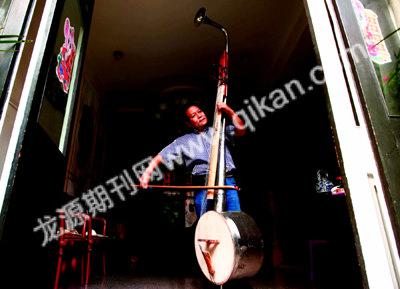Musical Instrument Maker Recycles Waste Materials
2009-06-08ZhangYi
Zhang Yi

Fang Zengrui, a canned food technician during all his work years, began to make musical instruments out of recycled materials after his retirement. His ingenious capability to turn waste materials into miraculous musical instruments has been covered in news media such as CCTV and Xinhua News Agency.
A college graduate from the Chinese department of Hangzhou University, Fang has a wide range of hobbies and talents and his passion for Chinese culture has made his life interesting. He worked in a cannery before his retirement. The idea of making musical instruments germinated in his heart when he found an expensive Erhu he bought for his wife failed to function well only few months after its purchase. He used some recycled materials and made one for his wife. The sweet words from the wife opened the eyes of the husband. He wondered how many musical instruments he could make out of waste materials.
The next three years saw him tinker around. He ended up making over 100 musical instruments in the traditional four categories: string instruments, plucked instruments, wind instruments, and percussion instruments. Today the two walls of the sitting room in his house are fully decorated with all his unique musical inventions.
The traditional Chinese Erhu, a two-stringed fiddle, is usually covered with a piece of python skin over one end of the sound cylinder. But the wild python skin has long been banned for making the fiddles. To find a substitute material, he tried numerous kinds of nylon papers and fabrics. Finally he zeroed in on a fabric used for street advertising boards, which is a suitable substitute for the python skin. The endurable material produces quality sounds after it is tightly stretched across the mouth of the sound cylinder.
The initial success gave Fang Zengrui enormous pleasure. He was greatly motivated to do more. New experiments began. Each of the instruments in his sitting room tells a story. The recycled things that came into these instruments are amazing. Take a bass fiddle for example. The sound cylinder is a big stainless steel wok whose mouth measures 50 cm in diameter. The wok with a leaking crack had come from a recycle station. The sound pipe of the bass fiddle is an exhaustion pipe of a motorcycle and it is topped with the trumpet part of a Suona. Four tuning pegs are installed on the metal trumpet part for tying the strings from the pegs to the bottom of the stainless wok. To calculate how melodious sounds could be made, Fang experimented for months on the wok. Though the bass fiddle looks very strange, the sounds are by no means inferior to those made on a real double bass.

Other types of Chinese fiddles manufactured by Fang all have strangest objects as sound boxes, such as a wine bottle, a porcelain bowl, a glass bottle, a coconut shell. Most wind instruments are made of used plastic water tubes.
The biggest fans of Fang Zengruis unusual musical instruments are dozens of musicians at the Ruian Folk Orchestra, a local group of folk musicians. They kindly encouraged Fang to make instruments in the first place. And when the instruments were made, they tried them out. Xi Jian, the band leader who has long been supportive of Fangs efforts, looks forward to using these musical instruments for a concert.

Of course, Fang is by no means just an ingenious craftsman who has made musical instruments out of recycled materials. He is sort of a unique musician, for the instrument he plays is a single-stringed fiddle, based on an ancient Chinese prototype. Experts say that the single-stringed fiddle goes back to the Shang Dynasty (c. 17th century BC to 11th Century BC). The techniques for making and playing the instrument have been passed on father to son all these thousand years. It is why a single-stringed fiddle is so rare in China today.
One day a friend brought home a box-typed single-stringed fiddle from Vietnam. Fang saw the fiddle and was totally obsessed. He couldnt stop trying out ideas to reproduce one for himself. To tune tones and find the best resonations, he experimented for six months. With the problems solved, he bought a large chunk of root from a second-hand antique market and made it into a structure for the fiddle.
With the instrument made, Fang decided to play it. He practiced so hard that his fingers became swollen, but he finally mastered the fiddle. His performance brought down the house in Wenzhou on many occasions. Some business tycoons offered to buy the fiddle, but Fang declined all these offers.□
